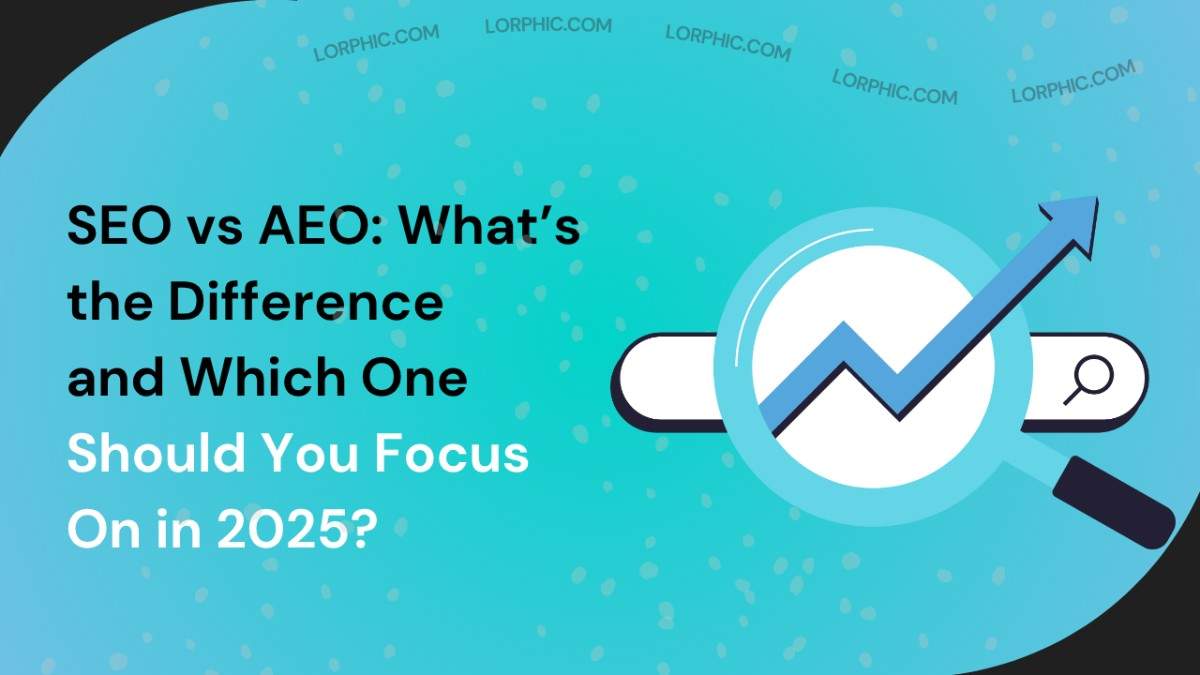For decades, Search Engine Optimization (SEO) was the undisputed heavyweight champion of online marketing. The objective was straightforward: make it to the top of Google’s search pages. But times are changing. With AI chatbots, voice assistants, and increasingly advanced search algorithms coming online, a new player has emerged: Answer Engine Optimization (AEO).
This transformation from search to answers is altering the way we locate information and the way that businesses must position themselves to be discovered. Is SEO still applicable? Is AEO the new monarch? Or does the situation have more sophistication? In this guide, we will dissect what is the difference between SEO and AEO, how they complement each other, and assist you in determining where you should direct your energy in 2025.
What is SEO (Search Engine Optimization)?
Search Engine Optimization (SEO) is the process of improving a website and its content so that it ranks higher on search engine results pages such as Google or Bing. The main goal is to increase organic traffic by helping search engines recognize your content as relevant, trustworthy, and valuable for users.
In simple terms, SEO helps your audience find you naturally when they search for topics, products, or services related to your business. It combines different techniques that work together to improve visibility and performance online.
SEO can be divided into three main categories:
- On-Page SEO: This involves optimizing individual web pages. It includes keyword research and placement, creating high-quality content, optimizing meta titles and descriptions, using header tags (H1, H2, H3), and ensuring images have descriptive alt text.
- Off-Page SEO: This refers to actions taken outside of your own website to impact your rankings. The most significant factor here is backlink building, earning links from other reputable websites, which acts as a vote of confidence in your content.
- Technical SEO: This focuses on the backend of your website to ensure search engine crawlers can easily find, understand, and index your content. It includes site speed, mobile-friendliness, site architecture, and using structured data (Schema markup).
For the past two decades, SEO has been the foundation of digital visibility. By following best practices and aligning with how search engines evaluate content, businesses have consistently attracted visitors who are actively searching for the solutions they offer.
What is AEO? (Answer Engine Optimization)
Answer Engine Optimization (AEO) is the process of creating and organizing content so it provides direct, accurate, and easy-to-understand answers to user questions. While SEO focuses on helping a webpage rank higher, AEO focuses on having your content selected as the exact answer that appears in search results or through artificial intelligence tools.
Think about the last time you asked a question using Google, Siri, Alexa, or ChatGPT. Instead of getting a list of links, you probably received one clear answer. That is how answer engines work. They gather and summarize information from different sources to provide the best possible response to a user’s question.
AEO helps ensure your content becomes the source for those answers. It involves a few important steps:
- Understanding User Intent: AEO begins by identifying what users are truly asking. It focuses on understanding the real purpose behind their questions instead of just analyzing keywords.
- Providing Clear and Factual Answers: Your content should deliver information that is correct, concise, and easy to understand. Both readers and AI systems should be able to quickly identify the key message.
- Using Structured Data: Adding structured data, also known as schema markup, helps search engines interpret your content more effectively. For example, you can indicate whether your content is a recipe, an FAQ, or a review.
- Optimizing for Natural Language: Since most people now use voice or conversational searches, your content should sound natural and easy to read. Writing in a conversational tone helps answer engines match your content with how real people ask questions.
- Establishing Authority and Trust: Search engines and AI tools prioritize content from reliable and knowledgeable sources. Building your brand’s credibility through well-researched and helpful content increases the chances of your information being selected as an authoritative answer.
In simple terms, AEO is about making your content the most accurate and trusted solution to a user’s question. As search continues to evolve toward direct answers and AI responses, mastering AEO ensures your brand stays visible and relevant in this new era of search.
What is the Difference Between SEO and AEO?
While Search Engine Optimization (SEO) and Answer Engine Optimization (AEO) share the same ultimate goal of connecting users with the right information, they focus on achieving it in very different ways. SEO aims to improve a website’s visibility and ranking, while AEO focuses on getting your content chosen as the direct answer to user queries.
Here is a clear comparison between the two approaches:
| Feature | Search Engine Optimization (SEO) | Answer Engine Optimization (AEO) |
| Primary Goal | To make a webpage rank higher on search engine results pages. | To have your content selected as the most accurate and direct answer to a question. |
| Main Focus | Keywords, search volume, and general topics. | User intent, context, and specific question-based content. |
| Outcome | Generates clicks and traffic to your website. | Generates visibility through featured snippets, voice search answers, and AI-driven responses. |
| Content Format | Long-form articles, blog posts, and detailed landing pages. | Concise and structured answers such as FAQs, how-to guides, lists, and short summaries. |
| Technical Emphasis | Website speed, backlinks, mobile optimization, and domain authority. | Structured data, natural language processing, and voice-friendly formatting. |
| User Interaction | Encourages users to click links and explore more pages. | Satisfies the user instantly by providing the full answer within the result. |
| Measurement of Success | Organic traffic, rankings, and backlink quality. | Featured snippet appearances, voice search results, and AI answer selections. |
| Content Language | Focused on keyword optimization and readability for search algorithms. | Written in conversational and natural language that matches how people ask questions. |
| Search Behavior Targeted | Traditional text-based searches. | Voice searches, AI chat responses, and conversational queries. |
| Future Relevance | Continues to be essential for building online presence and traffic. | Becoming increasingly important as AI and voice search shape the future of information access. |
SEO aims to get the search engine to link to your webpage, driving visitors to your site.
AEO aims to get the search engine or AI system to use your content as the direct answer, even if the user does not click through to your website.
How SEO and AEO Work Together?
Answer Engine Optimization (AEO) is not a replacement for Search Engine Optimization (SEO), it is the next stage in its evolution. While AEO focuses on providing direct answers, it relies heavily on the strong foundation built by traditional SEO practices.
Search engines and artificial intelligence systems still depend on SEO signals such as authority, trust, relevance, and clarity to decide which sources are reliable enough to use as answers. In other words, good SEO helps your content get discovered, and AEO helps it get chosen.
Here is how both strategies complement and strengthen each other:
SEO Builds the Foundation
A well-optimized website is the starting point for both SEO and AEO success. A fast, secure, and mobile-friendly site allows search engines to easily crawl, understand, and index your content. Without a technically strong website, even the best answers may never be found by users or answer engines.
Content Quality Drives Both Strategies
High-quality content is at the heart of both SEO and AEO. SEO helps your content gain visibility in search results, while AEO helps that same content become the chosen answer. When your content is accurate, engaging, and well-researched, it performs well across both traditional and AI-driven searches.
Backlinks Build Credibility and Trust
Earning links from reputable websites signals to search engines and answer engines that your content is credible and worth referencing. This form of authority is a major factor that both SEO and AEO use to evaluate trustworthiness and expertise.
Structured Data Enhances Discoverability
Adding structured data, such as schema markup, supports both strategies by helping search engines interpret your content more effectively. It increases your chances of appearing in featured snippets, knowledge panels, and voice search results.
Shared Goal: Satisfying User Intent
Ultimately, both SEO and AEO work toward the same purpose, helping users find accurate, helpful information as quickly as possible. SEO brings users to your content, while AEO ensures your content delivers the most relevant answer once they arrive.
In simple terms, SEO earns your place in search results, and AEO helps your content become the trusted answer people see first. Together, they create a complete digital strategy that improves visibility, authority, and user satisfaction in an AI-driven world.
Which One Should You Focus On in 2025?
In 2025, businesses should focus on combining Search Engine Optimization and Answer Engine Optimization. SEO builds a strong foundation by improving website speed, structure, and content quality, while AEO helps your information appear as direct answers in search and voice results. Start by creating clear, helpful content that answers real questions people ask online. Organize it with headings, bullet points, and short paragraphs so both readers and search engines can understand it easily. Use structured data to help AI tools recognize your content, and write in a natural, conversational tone. Together, SEO and AEO make your brand more visible, trusted, and future-ready.
Conclusion
The evolution from search engines to answer engines marks a fundamental shift in how we access information. While SEO remains the foundation of digital visibility, AEO is the framework for future success. By understanding the differences and synergies between the two, you can create a robust strategy that not only attracts traffic but also establishes your brand as the definitive answer in your field.
Don’t view this as a threat to your current efforts. See it as an opportunity to connect with your audience in a more direct and meaningful way. Start optimizing for answers today to secure your visibility in 2025 and beyond.




